Italian Pickled Eggplant, don't let the process intimidate you! Prepare authentic homemade pickled eggplant that doesn't compare to store bought and serve as antipasto, in sandwiches or even on pizza. Deliciously flavored with garlic, dried chilis, oregano and fennel seeds just like my mom makes!
Note: This recipe was updated on September 21, 2023, specifically regarding the storage method.
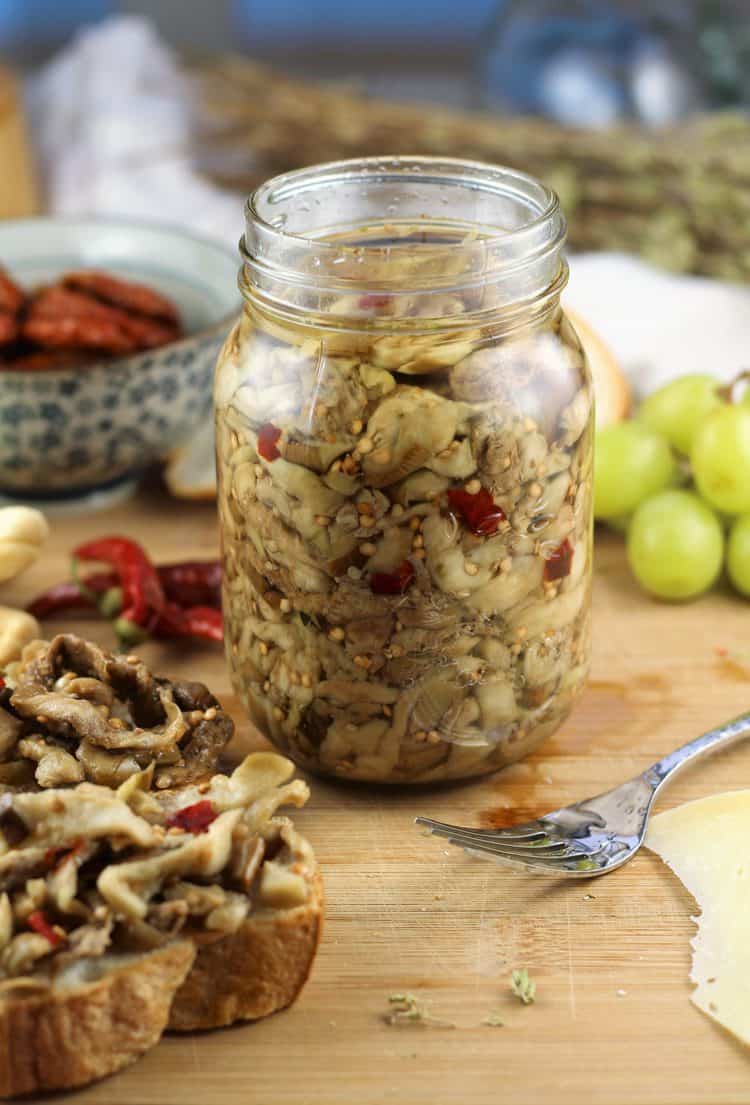
Yet another eggplant recipe on my Sicilian food blog! Of course, there's no end to Sicilian recipes with eggplant. But this is no ordinary eggplant recipe, in fact it requires no cooking whatsoever. Italian pickled eggplant is what many Italians are preparing this time of year. That is along with peppers, tomatoes, giardiniera, tomato sauce and so on.
I'm going to admit something to you, I actually don't can tomatoes with my family. There, I said it. I tried once or twice in my garage, as most Italians do. Now I know I may face backlash for saying this, but I just felt that it was quite labor intensive and not worth the effort. I buy my tomato passata imported from Italy at my local Italian grocery store and stock up when it's on sale.
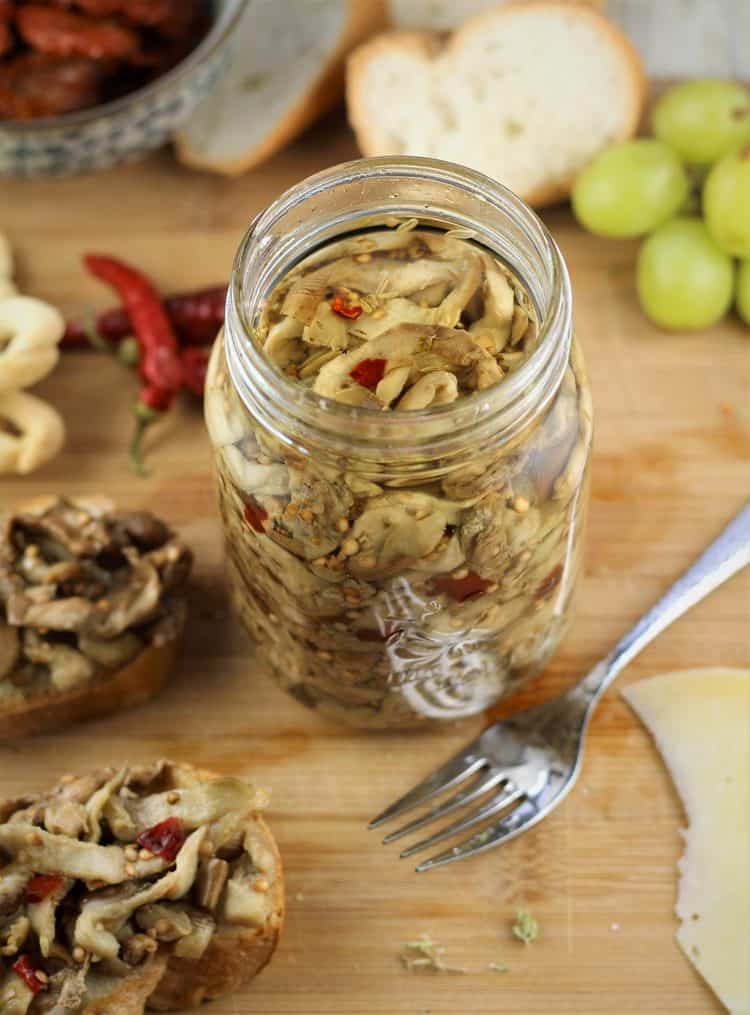
So now that I got that out of the way, I decided to focus my time on preserving other vegetables, such as Italian Pickled Eggplant. My son goes through several jars each year adding them to sandwiches, salads and even in stuffed pizza. So I decided it was time to learn my mother's easy method for pickling eggplant, and while we're at it involve my son in the process as well.
Choosing the right eggplant for pickling:

We began the day with a trip to the Jean-Talon Market. Those of you who live in Montreal or have visited our fine city know that the Jean-Talon Market is THE place to go if you're a foodie. Honestly, I become giddy with excitement when I'm there surrounded by all the amazing colorful fruits and vegetables and I want to buy everything in sight! It's open year round but I prefer visiting during the summer months.

I followed my mom around the market in search of the right eggplant. We must have circled the market at least three times looking for the best quality at the best price. I probably would have purchased the first ones I saw!
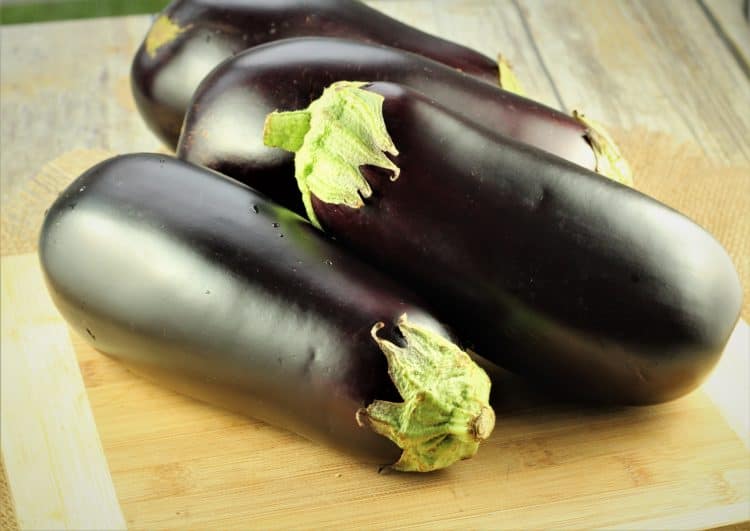
We finally settled on these beautiful globe eggplant. Look for eggplant that is firm and not bruised or wrinkly looking. It is also preferable to choose small to medium sized eggplants that have less seeds than the larger variety. But honestly,just about any variety of eggplant will do.
Equipement
Not much at all actually! This recipe involves no cooking whatsoever, so no pots or pans needed here. Here's all you need:
- cutting board
- sharp knife
- non-reactive bowls (2 if you make the full recipe): ceramic, stoneware, or glass bowls are best.
- colanders (2)
- a couple of salad plates to place upside down over the eggplant and place a weight on top (full explanation further below)
- heavy objects to press down on the eggplant during the various stages of pickling: a large tomato can; a plastic bottle of oil or white vinegar or even some paving stones that you may have lying around will do (which is what I used). I rinsed them and placed them in plastic bags to make sure they didn't come into direct contact with the eggplant.
- jars for storage: I used 3 -500 ml Mason jars with double lid system. Any jars will do as long as they are sterilized.
- fork: to press down on the eggplant to ensure it is tightly packed in the jars.
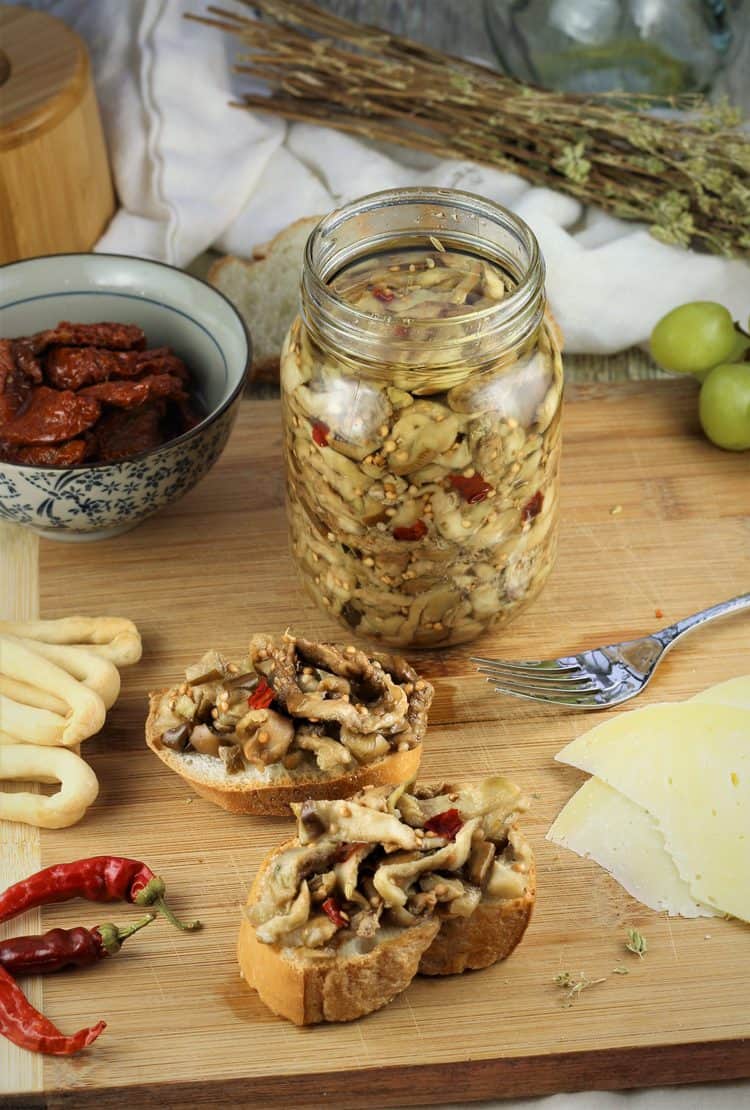
Step by Step Instructions
The method I am sharing is a tried, true and tested recipe that my mother has used for several decades and her family made in Sicily as well. You'll notice the prep time in my recipe card says 54 hours, but don't let that intimidate you. Most of the time is inactive time waiting for the eggplant to soak or drain excess liquid.
Also, please note that due to the large amount of eggplant, the cut eggplant strips were divided into 2 bowls. Repeat all steps for both bowls. The complete, printable recipe card is at the bottom of this post.
Day 1 - Salt the eggplant
Wash the eggplant and dry well. Remove some of the peel. You'll notice we removed strips of peel and left about half of it on. This is really a question of preference, you can remove all of it, none or half as we did.
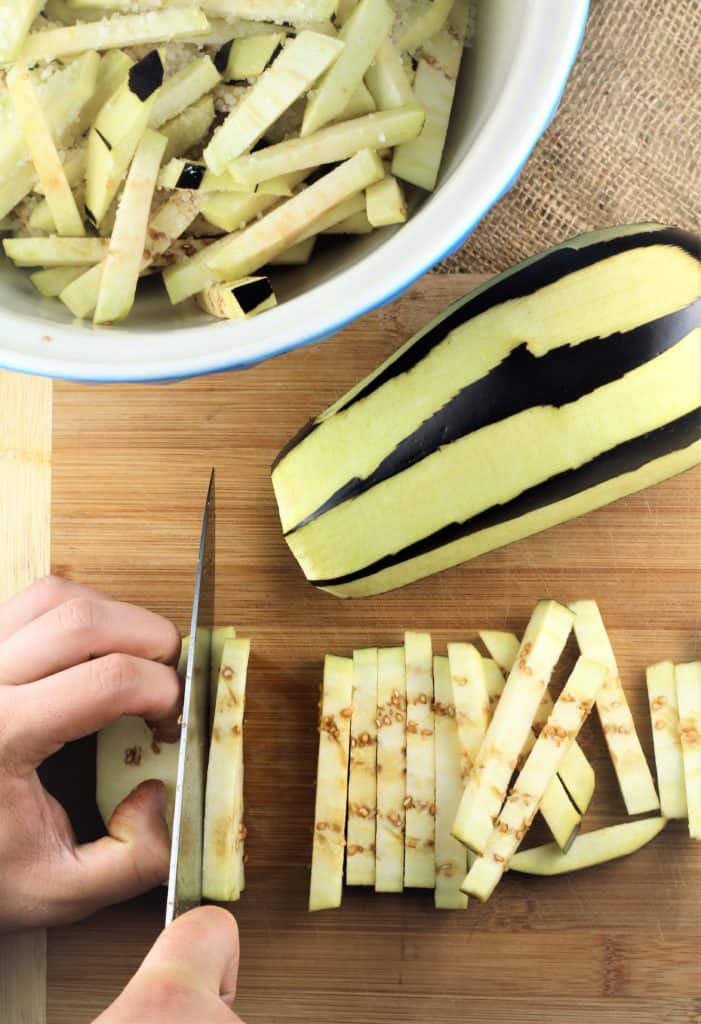
Slice into approximately 1 cm rounds and then into matchsticks of about ¾ cm.
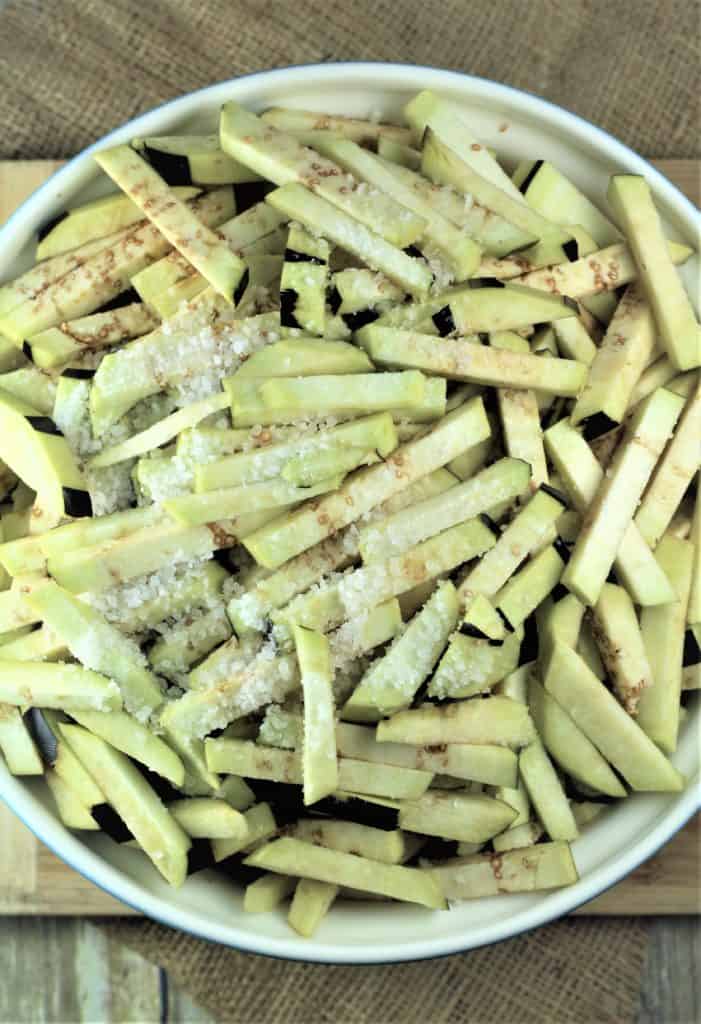
Divide the eggplant strips into 2 large non reactive bowl adding course salt in between layers of eggplant. Place a dinner plate over the eggplant strips and weigh the plate down with a heavy object of your choice. This can range from a large heavy can, a full bottle of oil or vinegar (in a plastic bottle!) or I happen to have a few paving stones handy that I later covered in a plastic bag.
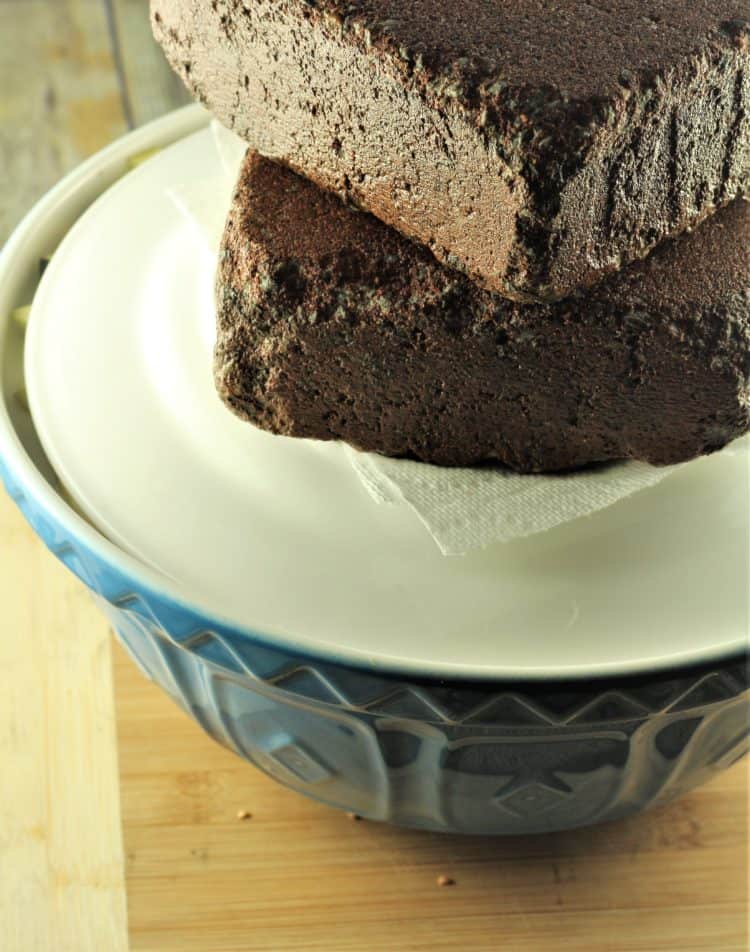
Let sit on your counter for 24 hours. After a few hours you'll notice I switched to a salad plate. With time the larger sized dinner plate was too wide to adequately press down on the eggplant.
Day 2 - Stir in vinegar
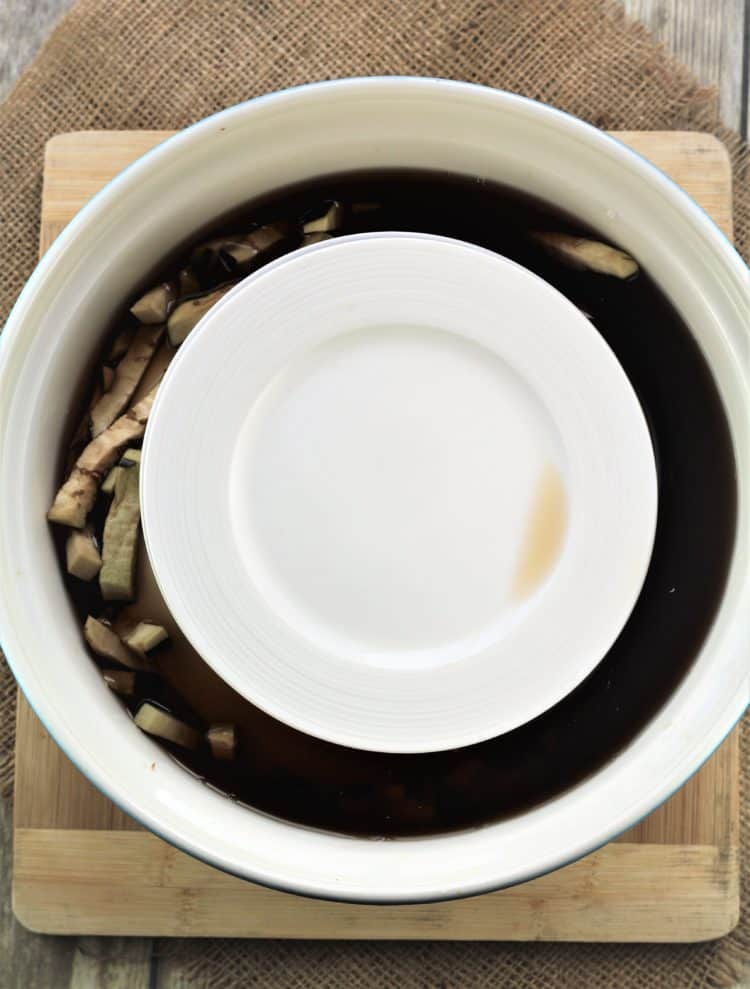
After 24 hours, you'll now notice the dark colored water surrounding the eggplant strips as well as the fact that they have greatly reduced in volume. The salt in the eggplant draws out the water and bitter juices from the eggplant. This is what you are looking for.
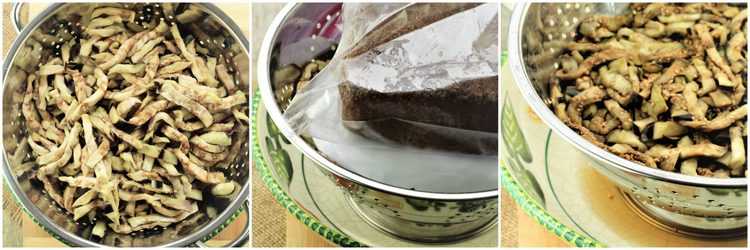
Drain the eggplant in a large colander. Place the colander over a bowl and once again, place a plate over the eggplant and weigh it down with your heavy object. This is to squeeze out as much of the water as possible.
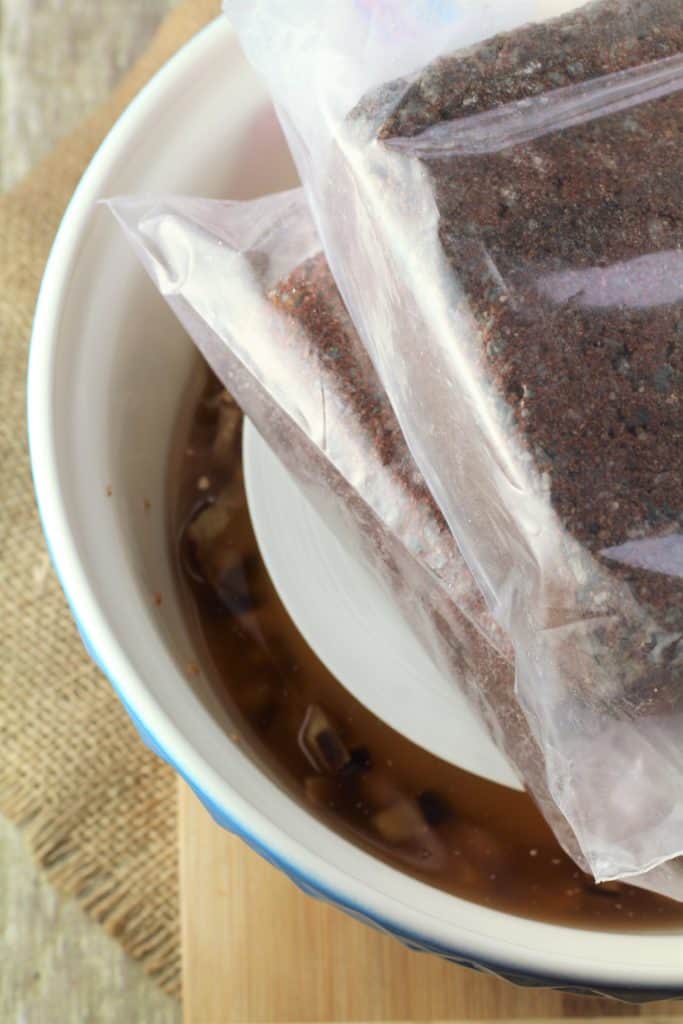
After 2 or 3 hours, transfer the eggplant back to your large bowl and stir in white vinegar. Once again, place your plate over the eggplant and weigh it down for another 24 hours.
Day 3-Place in jars
You're now ready to place your eggplant in jars. Sterilize your jars and lids following the easy method outlined here. I used 3 -500 ml jars.
Drain the eggplant strips in your colander and as you did the previous day. Weigh them down once again for 2-3 hours hours to drain out all the vinegar.
Next, squeeze out as much water as possible by taking a handful of eggplant strips at a time and squeezing them with your hands. You'll be surprised to see how much more liquid comes out of them!
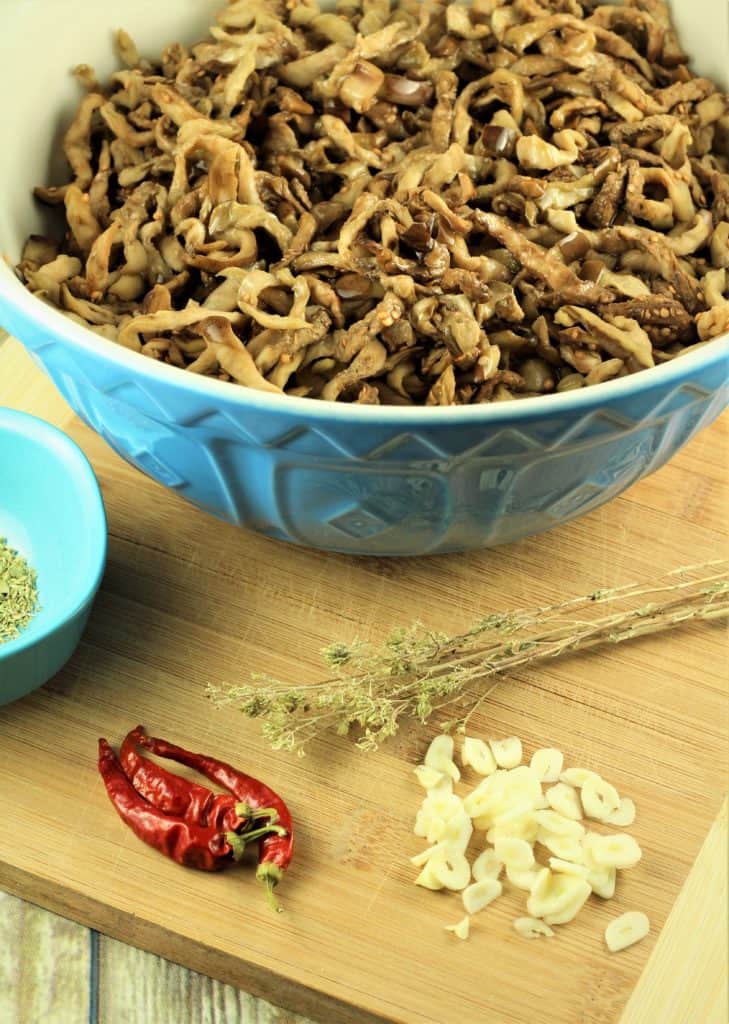
Place the squeezed eggplant back in your bowl. Toss with oil; slivered garlic; dried chili torn into small pieces; dry oregano and, if desired, a few fennel seeds.
Drizzle a little oil at the bottom of each jar to coat it. Begin packing in the eggplant strips using a fork and pressing down firmly to pack the eggplant in as tightly as possible. Continue until you reach approximately 2.5 cm below the top of the jar. Pour in enough oil to cover the eggplant but not too much so that the lid touches the oil.
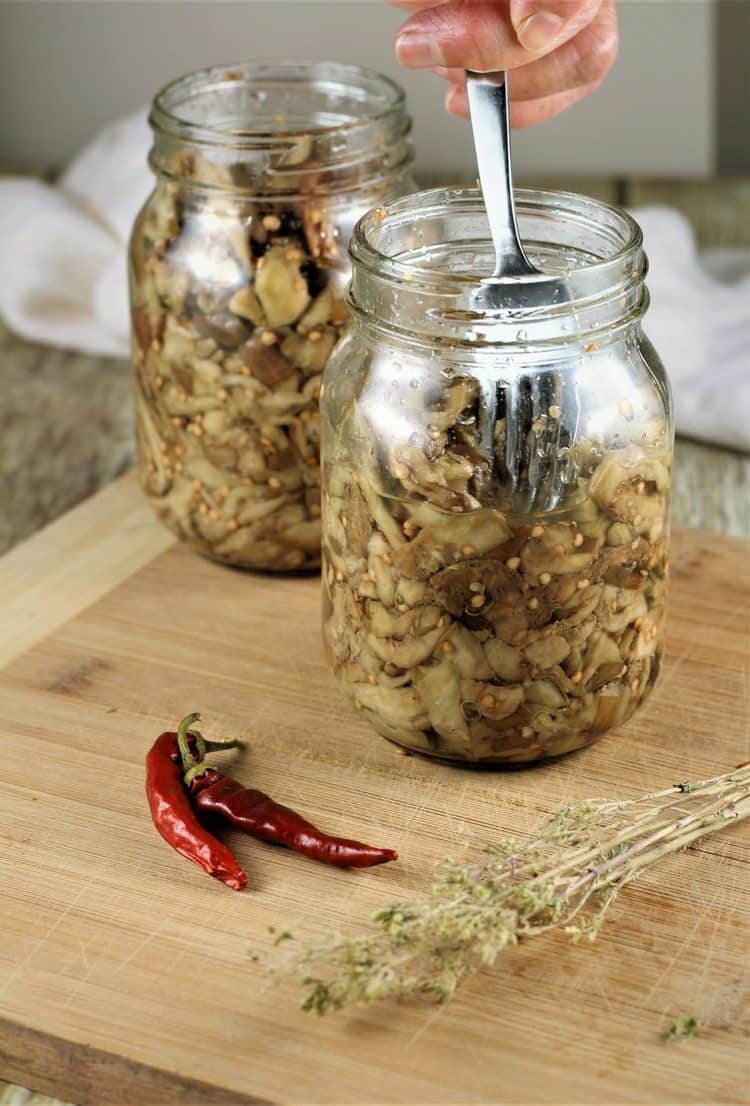
Place the lid on the jar, but not too tightly yet. Let the jars sit for a few hours and if you notice they have absorbed more oil and are no longer completely covered with oil, remove the lid and pour in extra oil. Now place the lid on tightly. Continue with the other jars.
Storage
Store pickled eggplant jars in a dark, cool place. Most Italians have a cold room or cantina which is filled with shelves full of jars of pickled veggies, tomato sauce and the occasional prosciutto hanging from the ceiling!
Here are a few options on how to store your pickled eggplant:
- The recommended method of storage is refrigeration. Once a jar is opened it is best used within 2-3 weeks. Since this recipe uses vegetable oil instead of olive oil, it will not coagulate in the refrigerator.
- Sealing the jars by means of a water bath is not recommended for pickled vegetables that are in oil.
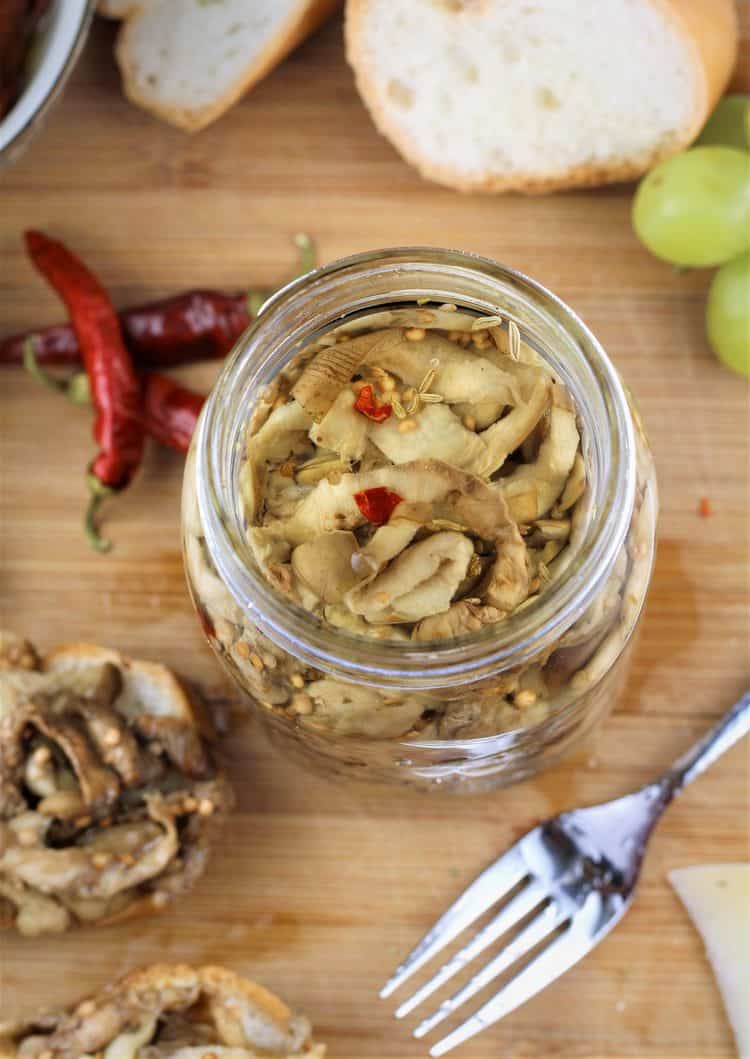
Once the jar is opened, store in the refrigerator and continue to top the eggplant with oil if not completely covered.
To serve
-Pickled eggplant is typically served as antipasto (appetizer) with fresh crusty bread before a meal.
-Add to your antipasto platter surrounded by other pickled and cured ingredients such as cold cuts; other pickled vegetables; cheeses; and olives.
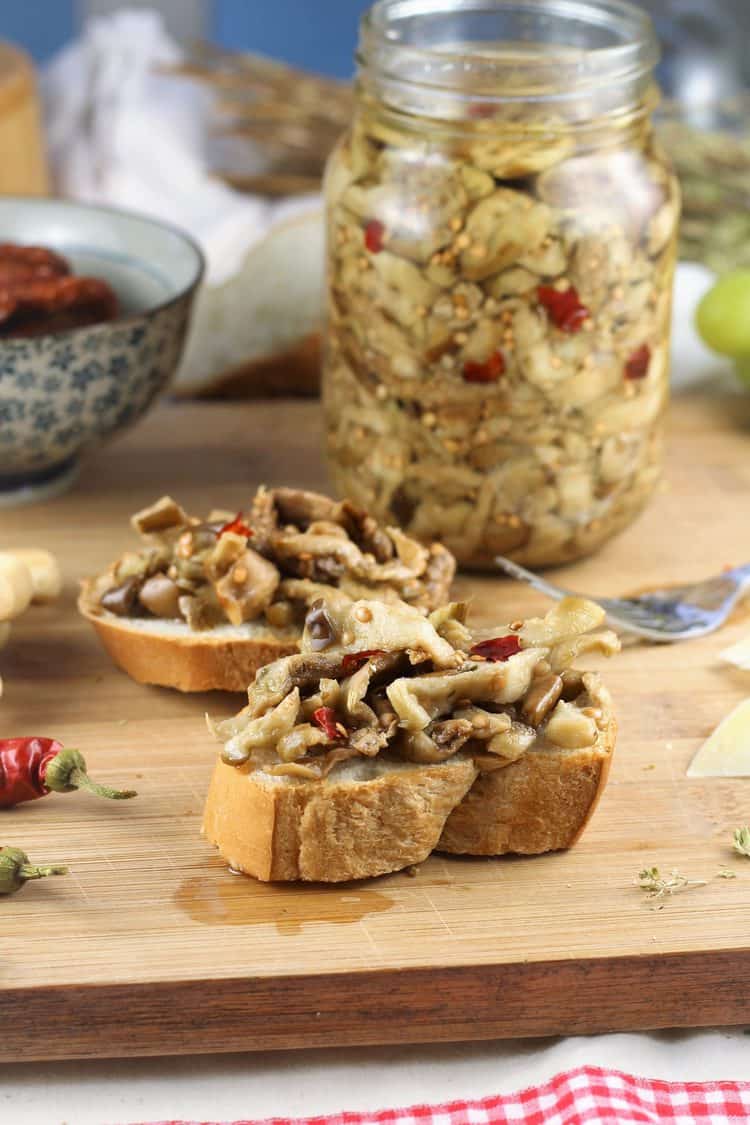
-One of our favorite ways of enjoying pickled eggplant is in sandwiches especially in a sausage panini, or even in a stuffed pizza such as a rotolo or calzone.
Tips and suggestions:
- This recipe will work well with just about any type of eggplant. Just be sure to look for fresh eggplants that are firm and are not wrinkly.
- Vary the flavoring ingredients: mint, basil, or parsley are a few suggestions.
- My mother uses a neutral flavored oil such as vegetable oil (canola or sunflower oil are other options) since olive oil solidifies when refrigerated. But you can use olive oil if you prefer.
- Refer to the section above on how to store pickled eggplant.
- The eggplant is ready to eat right away, however it is best enjoyed after at least a month when the flavors have had time to mingle and the eggplant becomes increasingly tender.
- This recipe makes 3 -500 ml jars (16 ounces or 2 cups), but if you find it difficult to consume such a large quantity once refrigerated, try using 6 -250 ml jars instead.
- The recipe may also be halved to fill 3 -250 ml jars.
I hope this recipe inspires you to try pickling your own vegetables this Fall. You can pickle a variety of vegetables with this same technique including hot peppers (recipe coming soon) and green tomatoes. If you give it a try let me know how yours turned out by rating this recipe in the recipe card below. Feel free to Pin the recipe for later. Happy pickling!
How about a few more eggplant recipes for you to enjoy?
- Eggplant Caponata
- Sicilian Baked Rice and Eggplant Timbale
- Eggplant Caponata with Swordfish
- Eggplant Involtini with Ricotta and Spinach
- Eggplant Calzone alla Norma
- Stuffed Eggplant and Peppers in Tomato Sauce
- Melanzane in Carrozza
- Baked Eggplant Meatballs
- Baked Eggplant and Potatoes with Tomato Sauce
- Grilled Eggplant Involtini
- Stuffed Baby Eggplant
- Mom's Eggplant Parmigiana
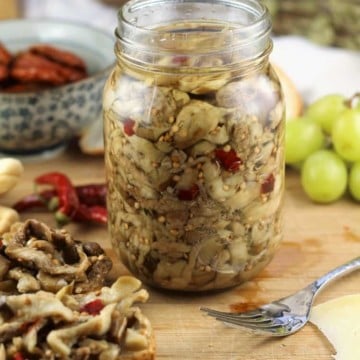
Italian Pickled Eggplant
Equipment
- Cutting board
- Sharp knife
- Non reactive bowls: ceramic, glass, or stoneware are fine
- Colanders
- Salad plates
- Heavy object: large tomato can; large plastic bottle of oil or vinegar; stones
- Jars: 3 -500 ml jar or the equivalent
- Fork: to press down on the eggplant when placing in jars
Ingredients
- 5 kg eggplant (or 11 lbs) I used 8 of the common globe variety
- 1 cup coarse salt
- 3 cups white vinegar
- 3 cups vegetable oil or any other neutral flavored oil such as sunflower or canola, plus more for topping jars
- 3 garlic cloves slivered
- 1 -2 dried hot chilis or more according to taste
- 2 tablespoon dry oregano
- 2 teaspoon fennel seeds
Instructions
- Please note that due to the large amount of eggplant, I divided the cut eggplant strips into 2 bowls and each step outlined below is repeated with each bowl.
Day 1 - Salt the eggplant
- Wash eggplant and dry well. Remove some of the peel. We removed strips of peel and left about half of it on. This is really a question of preference, you can remove all of it, none or half as we did.
- Slice each eggplant into approximately 1 cm rounds and then into matchsticks of about ¾ cm.Place in 2 large non reactive bowls adding course salt in between layers of eggplant.
- Place a dinner plate over the eggplant strips and weigh the plate down with a heavy object of your choice. This can range from a large heavy can, a full bottle of oil or vinegar (in a plastic bottle!) or I happen to have a few paving stones handy that I later covered in a plastic bag. Let sit on your counter for 24 hours. After a few hours I switched to a salad plate as you need the weight of the heavy object to press down on the eggplant.
Day 2 - Stir in vinegar
- After 24 hours, a dark colored water will surround the eggplant strips and they will have greatly reduced in volume. The salt in the eggplant draws out the water and bitter juices from the eggplant. This is what you are looking for.
- Drain the eggplant in a large colander. Place the colander over a bowl and once again, place a plate over the eggplant and weigh it down with your heavy object. This is to squeeze out as much of the water as possible.
- After 2 or 3 hours, transfer the eggplant back to your large bowl and stir in white vinegar, (dividing the amount specified between both bowls.) Once again, place your plate over them and weigh them down for another 24 hours.
Day 3 - Place in jars
- You're now ready to place your eggplant in jars. Sterilize your jars and lids following the easy method outlined here. I used 3 -500 ml jars.
- Drain the eggplant strips in your colander and as you did the previous day and weigh them down once again for 2-3 hours to drain the vinegar. Next, squeeze out as much water as possible by taking a handful of eggplant strips at a time and squeezing them with your hands. You'll be surprised to see how much more liquid comes out of them!
- Place the squeezed eggplant back in your bowl. Toss with oil; slivered garlic; dried chili pepper torn into small pieces; dry oregano and, if desired, a few fennel seeds. Once again the ingredients listed are divided between both bowls.
- Drizzle a little oil at the bottom of each jar to coat it. Begin packing in the eggplant strips using a fork and pressing down firmly to pack the eggplant in as tightly as possible. Continue until you reach approximately 2.5 cm below the top of the jar.
- Pour in enough oil to cover the eggplant but not too much so that the oil reaches the lid. Place the lid on the jar, but not too tightly yet. Let the jars sit for a few hours and if you notice they have absorbed more oil and are no longer completely covered with oil, remove the lid and pour in extra oil. Now place the lid on tightly. Continue with the other jars.
- See notes below for storage methods.
Notes
- This recipe will work well with just about any type of eggplant. Just be sure to look for fresh eggplants that are firm and are not wrinkly.
- Vary the flavoring ingredients: mint, basil, or parsley are a few suggestions.
- My mother uses a neutral flavored oil such as vegetable oil (canola or sunflower oil are other options) since olive oil solidifies when refrigerated. But you can use olive oil if you prefer.
- The eggplant is ready to eat right away, however it is best enjoyed after at least a month when the flavors have had time to mingle and the eggplant becomes increasingly tender.
- This recipe makes 3 -500 ml jars (16 ounces or 2 cups), but if you find it difficult to consume such a large quantity once refrigerated, try using 6 -250 ml jars instead.
- The recipe may also be halved to fill 3 -250 ml jars.
- Store your pickled eggplant jars in the refrigerator. Since this recipe uses vegetable oil instead of olive oil, it will not coagulate in the refrigerator.
- Once the jar is opened, use within 2-3 weeks.






Martino
Nadia, I found this recipe from you 2 years ago and have made so many batches since, I might finally make my Italian side of the family proud. I am IN LOVE with pickled eggplant using your mom's recipe! I make or buy garlic ciabatta, toast it, spread some basil pesto, and a bit of this eggplant: every bite amazing! I have stored this in the pantry for up to six months with no problem (Actually I was trying to store longer but I just kept opening a jar and eating it.) I made a batch once and pressure canned it (with sunflower oil) as a test and out of an abundance of caution and didn't see any difference in taste or texture, and I certainly never found a problem with mold, mildew, taste, etc and have never stored it in the refrigerator until after opening, although I rarely open a half pint jar without finishing it the same day. There is so much conflicting info about what's safe when it comes to eggplant, that I just threw caution to the wind. It worked for me, but maybe not for others. As I write this, I have 8 lbs of Japanese eggplant draining in a colander, getting ready for the vinegar addition tomorrow. I have tried this with white vinegar, apple cider vinegar, and asian rice wine vinegar and I love all of them. I've added fresh garlic, jarred pre-minced garlic, fermented peppers, pepper flakes, dried oregano, and all combinations of the above. Haven't found a combo I don't like yet. I just cannot thank you enough for this recipe.
Nadia
Hello Martino, thank you very much for your kind words, I'm thrilled to hear that you enjoy this pickled eggplant. I love your crostini idea too and like you we've never had any trouble with storing it. Thanks again and buon appetito!
Joseph Cennamo
Might be a good recipe but way too time consuming I have made pickled eggplant for years in less than half the time.
Nadia
Hi Joseph, just wondering if you actually tried it out. It seems time consuming but in fact most of it is waiting time with no hands on tasks to do, so actually quite easy and worth the effort!
Anna Mazzini
This is the traditional Sicilian way, faster does not mean better, and the vast majority of times it usually means "not as good". Eggplant can be bitter and the salting process and the squeezing the water takes out the bitterness and also firms up the eggplant, that step is not optional unless you like bitter and mushy eggplant. Some Italians, after they salt eggplant & drain out water, also blanche "wash" the eggplant in a 3 to 1 ratio of vinegar & water and than squeeze it out under weights. It also works well. Just remember too much vinegar can ruin your batch of eggplant. I try to use only female eggplant, they make a better end product, but in the store I very rarely see them, just male eggplants.
Nadia
Hello Anna, thank you very much for your feedback. Yes indeed my mom's recipe takes a couple of days but it is mostly inactive waiting time. She always preferred this method to boiling it for fear that they might turn out mushy, and it is really the best. Thanks again for chiming in!
Heather
Can I use fresh chili peppers in this recipe?
Thanks!
Nadia
Hello Heather, I have never used fresh chili peppers in mine however I don't see why it wouldn't work!
Lauri Starcher
Excellent instructions! After my favorite Italian store stopped making pickled eggplant, I was dying for some like my grandmother used to make. I just finished making mine using your awesome instructions and it turned out amazing! The only problem will be trying to wait a month to get the best possible taste. Thank you so much!!
Nadia
Thank you very much for your kind comment Lauri, I'm thrilled to hear you enjoyed this recipe!
Bruce
I’m a little confused on the quantity. I only had about 8lbs of eggplant, not the 11lbs as the recipe calls for. After 24 hour brining I have over 7 quarts. Not sure how to fit all of this into 3 pint jars. What am I missing?
Nadia
Hello Bruce, by the end of the entire process (salting, adding vinegar), if you have added sufficient weight to squeeze out all the water from the eggplant slices you'll notice that the volume of eggplant is considerably reduced. Also, they must be tightly packed in the jars to keep them well preserved. And this is how I managed to fit them in 3 -500 ml sized jars. Hope this helps and let me know how it goes!
Mary Pedersen
Can't wait to try this!!!
Nadia
Hi Mary, I do hope you enjoy it!
Michael
Dear Nadia,
thank you for the recipe - I am planning on trying it out tomorrow. Quick question: when you write "3/4 centimeters", do you mean "three to four centimetres" or "three quarters of a centimetre"? In your photo it looks like the former (three to four), but I wanted to make sure before I commit.
Thank you!
Nadia
Hi Michael, it is indeed three quarters of a centimetre. I do slice the strips of eggplant quite thin. sorry it wasn’t so clear. Hope you enjoy them!
Joanne Nigro
My aunt, who was the best Italian cook I ever tasted, had a trick about buying eggplant. She told me to look at the bottom of the eggplant. There is a brown mark on that end. Some are round, some are like a straight line. The eggplants with the slit are female and have lots of seeds. The round ones are male and have much less. I thought it was some old Italian thing. Then I tried it...and it works every time! Going to try your recipe as soon as I get some Bell jars. Thanks so much for sharing,
Nadia
Thanks for sharing Joanne, I'll try testing this theory out!
Robbie
Does this pickling process neutralise the solanine in the eggplants? So far I had always eaten them cooked due to this concern
Nadia
Hello Robbie, I am aware that cooking eggplant does reduce the solanine level however unfortunately I do not know enough about food science to answer your question and I do not want to give you the wrong information. I'm sorry that I could not be more helpful!
Jennifer Lynch
could you use olive oil instead of canola or safflower? I much prefer the taste of olive oil, even if not extra virgin. Thank you in advance for your reply!
Nadia
Hello Jennifer, you can however it will coagulate when you refrigerate the eggplant. It is not a problem, of course, and the oil will liquify once again when it comes to room temperature.
Heidi
Forgot to leave rating 🙁
Nadia
Thanks again!
Heidi
Hi Nadia - back in March 2021 (when we had 20kg+ eggplant from the garden) I made a big pile of this pickle. Thought you might like to know that one large jar, stored in the fridge, is still excellent today! I take some out, bring to room temp, and enjoy. At the time, I had trouble getting my head around the idea of using raw eggplant but following your process to the letter, and over time, it delivered the goods. So happy to have found this recipe. (Since then, though, our eggplant harvest has been more modest!) Thank you again!
Nadia
Hello Heidi, you are so lucky! I have not had as much luck growing eggplant in my garden. And I'm thrilled to hear you are still enjoying your pickled eggplant. It really does last a while! Thank you for sharing your experience with this recipe, I really appreciate you taking the time to do so. Grazie!
El
I found my eggplant was very very sour after the vinegar. I'm not sure if its suppose to be that way. Perhaps I put more vinegar than four cups - I didn't measure. I already added the oil and herbs. Is there any way to subdue thr vinegar taste after adding the oil?
Nadia
Hello El, it is possible that you used too much vinegar and that why I do recommend that you measure it first! I would not try to rinse off the vinegar at this point as it will affect the texture of the eggplant. Sorry I could not be more helpful!
Ryan
Hello. I am quite excited to make this as I have been on the hunt to find a copy of my Nona’s pickled eggplant recipe. It was her coveted secret. This seems incredibly close EXCEPT she always did hers as thin round slices (like she perhaps ran through a mandolin slicer).
Do you think there would be a problem to slice in rounds?
Nadia
Hello Ryan, yes I have seen that some people slice in rounds instead of match sticks and yes it is definitely ok for you to do that instead. Hope you enjoy this recipe!
Tania
Love Sicilians … Happy to be one! Best cooks!!!
Nadia
Agreed!
Renee
How long do these last unopened on the shelf?
Nadia
Hello Renee, I would not go past 6 months on the shelf, or if you're unsure the safer method is even in the fridge if you have space!
Nancy
I just started this recipe with eggplant from my garden and it looks wonderful! I have two questions: Firstly, is there a reason that you have the eggplant sitting in the fluid for the first 24 hours versus using a colander and draining it immediately as the fluid forms? (just curious) .
Secondly, how long can you leave the unopened jars in the refrigerator prior to opening for use?
thanks very much!
Nadia
Hi Nancy, I basically followed my mother’s instructions as this is how she always prepared hers. However I think your idea would work well too! As for keeping them in the fridge, I would suggest not beyond 6 months. Hope you enjoy!
Fabienne Grégoire
I decided to start making my own jars of my favorites store bought goodies since the price at the groceries stores has made a signigicant jump!!This was a fun process! I truly enjoyed every steps although the 50+ hours was intimidating; it is mostly idled time since most steps take 20 minutes max of prepping time each! I used 2 small Italian eggplants as test to see the results. I chose this recipe because the instructions were clear and I am from Montreal so I could relate. Thank you Nadia 🙂
Nadia
Hello Fabienne, fellow Montrealer, I'm so glad you enjoyed my mom's delicious recipe! And yes you are correct, it may seem intimidating but it is mostly waiting time. Thank you so much for sharing and hope you enjoy them!
Cindy Hartzell
Just made and smells great! Had a little taste and tastes great!
I know you said to Stott in fridge. I'm curious about the "after jar is opened" part. Does this mean it must first be sealed either by water bath canning or vacuum sealed? I didn't see that in the instructions. And in my "canning" mind, to open something means it first must be closed as in methods I already mentioned. Thanks in advance for clarifying.
Nadia
Hi Cindy so glad you enjoyed this pickled eggplant. You can not really seal these oil filled jars by means of a water bath method. So when I mean "open" I literally mean after you start a jar it should keep for a limited time only in the fridge.
Barbara T
I only did about 1/4 of the required of the recipe. I had about 2.5 eggplants and was going to make capponata but came across this recipe. It reminded me of my Sicilian Godmother and how spoiled our family was with all the delicious Sunday traditions! My husband who is for the north, loved everything about it! The smell, the look, the taste!
Now I’m on the search for pickled mushroom recipe. Buon appetito!
Nadia
Hello Barbara, I am thrilled to hear that both you and your husband enjoyed my mom's recipe! She has made these forever and I'm glad to have been able to share her wonderful recipe. Enjoy!
Cindy Hartzell
Ok, thanks for the information. I just wanted to be sure.
Susan Joubert
Absolutely delicious!!!! Will make sure to always have this in my pantry. Also makes such a nice gift to anyone!
Nadia
Hello Susan thrilled to hear you enjoyed them, and yes they would make a nice gift for sure. Thank you for your comment!
Darlene A. Ross
Do you have to preserve in oil? Is there a way to just use vinegar?
Nadia
Hi Darlene, I'm not sure if that would work as I have only preserved mine this way using my mom's recipe.
Melissa
Hi,
Thank you for sharing the recipe.
I've had my eggplant soaking for about 12 hours now and I'm looking forward to completing the recipe. I'm getting a little nervous about not waterbathing since it is just 2 of us and I would like to make sure we get to enjoy it all. If I do waterbath, are you aware of any needed recipe adjustments? Has anyone shared their experience with you regarding that?
Nadia
Hello Melissa, please note that the recipe was updated, specifically regarding the storage method. It is best to keep the jars of eggplant in the refrigerator and use within 2-3 weeks once the jar is opened. This is the safest method of storing them. Thank you for your comment and I hope you enjoy them!
Grace
How long do I soak it in Vinegar?
Nadia
Hello Grace, I soak the eggplant in vinegar for 24 hours as indicated in the recipe. Hope this helps!
Sarah
Hi
Can u use fresh chilli instead of dried chilli for the pickled aubergine recipe?
Nadia
Hi Sarah, although I have never tried this recipe with fresh chilis myself, I have known others who have used them instead of dry. Hope you enjoy them!